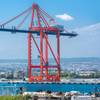Keppel FELS, Technip Completes Construction for P-52
The consortium of Keppel FELS and Technip has completed the offshore mating of the 25,000-ton topside and the 4,500-ton spider deck with hull structure, weighing 17,500 tons, for one of the world’s largest floating production platforms, the P-52, in Brazil. Considered the most challenging phases in the construction of the P-52 platform, this deck mating operation is highly complex and sensitive, and as such rarely carried out anywhere in the world.
This mega operation comprises two major phases. The first phase, which was concluded successfully in 24 hours on June 9 and 10, involved placing the topsides deckbox, with all process modules already pre-installed, onto the lower hull structure. The second phase involved the risky hoisting of the three major sections of the spider deck to join with the underside of the deckbox.
With these naval operations concluded, the P-52 floating production platform, in its final configuration, was towed back to Keppel FELS Brasil’s BrasFELS shipyard, where a 600-ton flare boom will be installed. The final hook-up of all systems is currently ongoing and the final testing and commissioning stage will commence soon.
The P-52 is an 81,000-ton (displacement) semisubmersible oil-processing platform. It is constituted basically of the hull, which remains partially submerged when it is operating in the oilfield, the deck box, the processing modules, modules for energy generation, gas compression, accommodation and utilities, and the helideck and recreational facilities. The construction agreement between the Keppel FELS/Technip consortium and Petrobras was signed in December 2003. The accommodation module, the structure of which is made out of aluminum, and the deck box, which houses all of the modules, were built at Keppel FELS Brasil’s BrasFELS shipyard, in Angra dos Reis. Production is expected to begin in early 2007.









